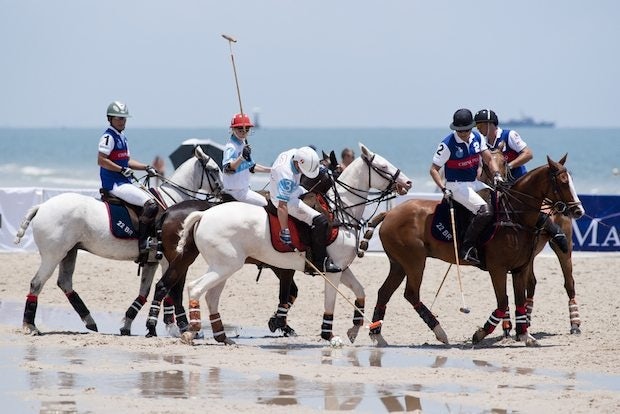
A Chinese polo team (blue jerseys) competes against a Thai team at a beach polo tournament in Hua Hin, Thailand. (Shutterstock)
The lunar Year of the Horse may be over in China, but for international equestrian sports dealers, it may have just begun.
In addition to spending heavily on luxury goods, cars, international real estate, and their own health, China’s ultra-wealthy are increasingly spending on another trapping of the global elite—equestrian sports.
While not new to China—polo clubs and racetracks have cropped up across the country over the past decade-plus—horse-riding sports have had a slow start in China thanks to the amount of time and training they require. Those in the industry remain optimistic about their future, however, as China’s upwardly mobile middle and upper-middle-class becomes the latest to aspire towards equine status symbols.
According to a recent Voice of America report, China now has some 300 equestrian clubs and 25 racetracks, among them Tianjin’s $2 billion “Equine Culture City” currently under construction. In addition to a racetrack, the new venue has a stunning 4,000 stables, training tracks, a clubhouse, and international equestrian college.
One major push for the development of equestrian sports in China is real estate as luxury developers add high-end recreation such as golf courses and polo fields to new projects. In addition to fostering an upscale image, these perks help their properties stand out in a saturated market filled with “ghost cities.”
As the infrastructure and interest in horses builds in China, this means big business for horse breeders worldwide. Horse dealers have been seeing an uptick in China sales in recent years, but there still remain logistical hindrances. Specifically, “bad dealings” between European sellers and Chinese buyers have hurt the cross-border trade. One Chinese expert told VoA that examples include Chinese buyers “attempting to bargain for horses, canceling deals and contracts at the last minute and even disappearing after a horse is en route to China and the seller has already spent thousands of dollars on the shipping procedures.”
Despite these setbacks, major horse sellers see no end to the opportunity in China as they focus on educating consumers about equestrian sports. As one American seller told VoA, “We’ve seen steady growth [in China] over the last three or four years. But the general theme is, our belief is that the market isn’t going to grow unless we get more training and assistance for clubs and more competitions. So that has been our focus for the last two years. We are putting on more horse shows, trying to show people that it’s easy to get involved, and that it is fun and not all about the money.”
Like other training-intensive luxury pursuits such as skiing and yachting, the infrastructure is being rapidly developed and a buyer market exists. The key is now to focus on convincing China’s affluent that the activities are worth the time and effort on a wide scale.